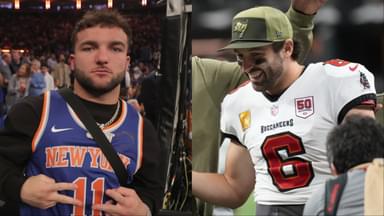When Tom Brady entered the NFL as a sixth-round pick in 2000, anyone predicting he’d finish with seven Super Bowl titles, 89,214 passing yards, and over 650 touchdowns would have been labeled delusional. Yet, Brady achieved it all.
Advertisement
TB12’s success wasn’t a product of luck or chance. It was the result of a relentless pursuit of precision, rigorous study, and an obsession with controlling every factor within his power.
And according to the man himself, a key part of that control came from mastering how to play the elements — quite literally. Yes, we are talking about the weather.
“I preferred outdoor, 70 degrees, humid,” Brady said on Veritasium’s YouTube channel. “Tiny little breeze, just to keep you cool.”
That’s the kind of weather most quarterbacks would circle on the calendar for days to avoid. But for Brady, it wasn’t just about comfort, it was about calibration. Outdoor games gave him a better feel, a smoother rhythm, and an even clearer visual grip on the game, he explained.
“I felt like my depth perception was a little better outside. I liked just the natural feel of the natural air. The dome always felt like a vacuum,” added Brady.
On paper, the GOAT’s preferences seem like a tiny variation in the factors. But as the level of the game increases, these small things become a major factor. A key reason why most quarterbacks love indoor stadiums for their ability to restrain variables like wind.
But Brady, who spent two decades in the swirling unpredictability of Foxborough, learned to treat the weather and outdoor conditions like an advantage, and not a burden. Because he trained in it… constantly.
“I’d say I practiced in it all the time,” he said. “I knew exactly what to wear for every single condition. Played 23 seasons, 100 to 120 practices a year… that’s over 2,000 practices.”
This kind of exposure gave the Patriots legend what many quarterbacks never get: A playbook not just for defenses, but for the skies above. Rain, wind, snow — he learned how the ball moved, how his grip changed, and how temperature affected the feel.
His attention to detail was so precise that Brady even knew which sleeves to wear at each temperature. “What’s the temperature? It’s 50 degrees? Okay, this is the shirt I wear. Oh, it’s 35 degrees? These are the two shirts I wear,” he revealed.
The NFL legend’s methods might sound obsessive. But with Brady, it was evidently worth it. The results speak for themselves.
In 383 career games, he threw more than 12,000 passes and completed a whopping 7,753 of them, while amassing nearly 90,000 passing yards. These aren’t just numbers that can be replicated by an average quarterback. By anyone, for that matter. They’re the outcome of an athlete who turned the physics of football into second nature.
Brady compared the precision with which he approached game days to how an F1 engineer fine-tunes a car for specific tracks, weather, and tire conditions. Every detail mattered, down to the brand of undershirt, the thickness of sleeves, and exactly how many heat packs to stuff into his hand muff based on the dew point.
And that’s the difference. While most quarterbacks hope for ideal conditions, Brady thrived in chaos. He didn’t wait for the weather to cooperate; he adapted until it gave him an edge.
So maybe, in a league defined by parity, where games are decided by inches and milliseconds, Brady’s obsession with control wasn’t a nerdy quirk or idiosyncrasy. Maybe it was the blueprint on how to become the GOAT.







